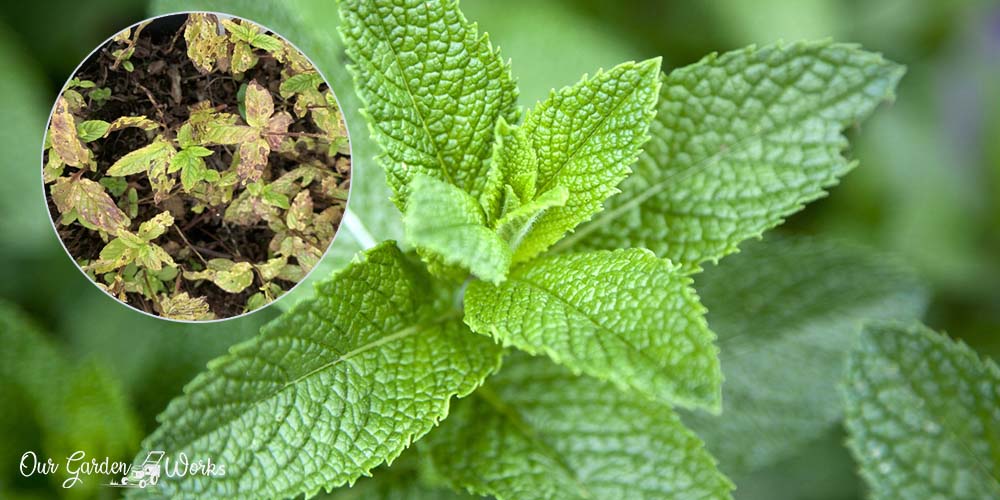Mint belongs to the famous herbs around the globe for its menthol flavor and fruity smell. They are easy to grow and can develop more than you could hope for.
However, there will always be some instances where mint leaves turn brown due to several factors.
In this post, we will discuss the top 7 reasons why your mint leaves are turning brown and how you can treat them.
It is also worth tackling the behavior of mint so you can take better care of it and keep it away from things that put its life at risk.
Let’s begin!
What Causes Mint Leaves To Turn Brown?
When it comes to changes in leaf color, many factors come into play. It can either be a problem with the plant’s nourishment, mismanagement, or it’s under attack by some type of fungus or pest.
To be more specific, here are the possible reasons why your favorite mint leaves are turning brown:
#1 Overwatering and Poor Soil Drainage
Like humans, plants can drown in water too. While it’s true that the leaves absorb the oxygen and moisture above the surface, roots breathe oxygen too. It is why gardeners avoid compact soil to aerate the roots and let the oxygen get into the top layer of the soil.
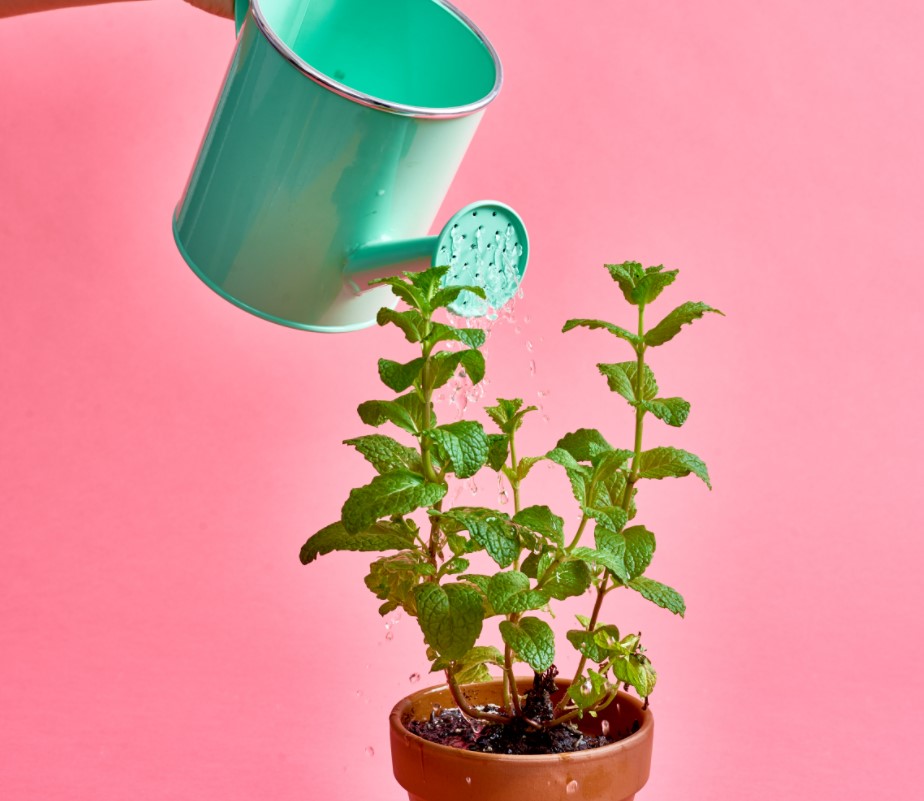
With too much water in the soil, the roots of mint plants will find it hard to get enough oxygen supply to perform major plant functions.
Once it enters its survival state, the plant will save all its energy to sustain and preserve the stem. Thus, leaving some leaves not getting the nutrients and start to turn brown.
Mints need 1 to 2 inches of water every week. They thrive in moist soils and benefit from the insulation provided by mulch.
If you notice that the container is already dripping, that means that you’re already overwatering it.
In some cases, you might be watering them correctly but the soil is too compact for the water to drain well.
An overwatered mint will show brown spots on the inner leaves or near the stem. If you notice these sudden brown spots, check on the soil if it is too clumped or soggy.
Consider re-potting the mint using light soil or a potting mix blended with compost to encourage good drainage.
When the problems seem to be due to excessive watering, then irrigate them less to prevent the roots from rotting. Observe if adjusting the irrigation resolves the brown spots.
If not, then other factors, like pests or diseases, might be causing the changes in the leaf color.
#2 Fungal Diseases
Fungal diseases are probably the first thing you’ll think about when you see mint leaves turning brown.
Well, you might be right about that if the brown spots are on the underside of the leaves, matched with yellow splotches of the topside of the same leaves.
Here are the common fungal diseases in mint that cause brown spots on the leaves:
1. Web Blight
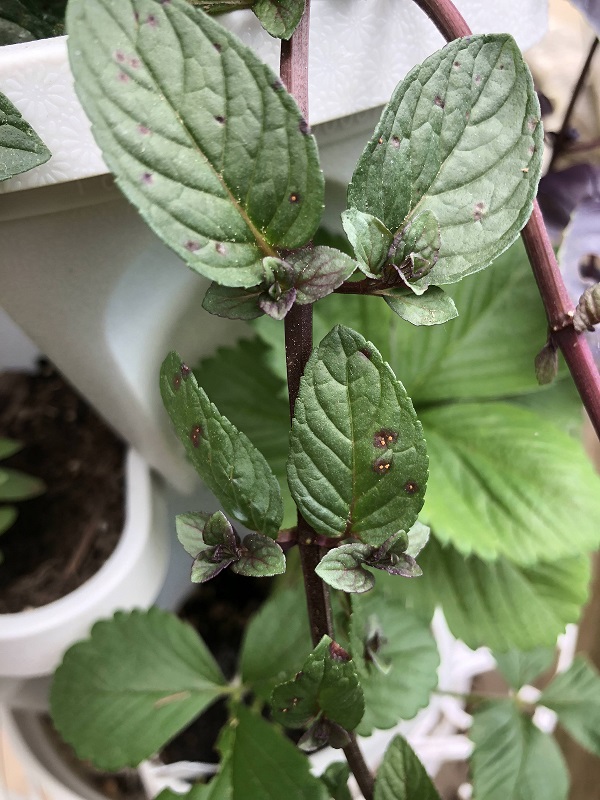
This is a fungal disease in mints caused by fungus. The fungus targets the stem of the mint and may also work its way ground up by infecting the lower leaves.
The lower leaves will start to turn brown to black and eventually wilt and die.
This fungal disease is contagious and can affect other plants in your garden, So, as soon as you suspect that your mint is infected, discard it immediately along with the soil.
You should also sanitize the pots and the tools that you use to avoid spreading the spores of the fungus to other plants.
2. Mint Rust
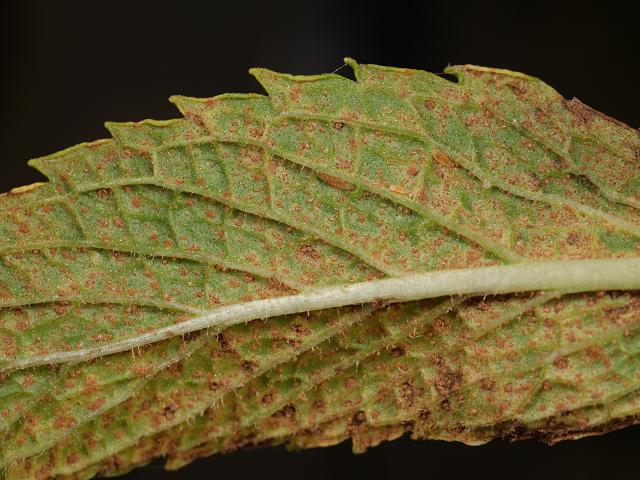
This is a common fungal disease in mints that causes brown and black spots on the underside of the leaves. It also creates yellow splotches on the top side of the leaves.
It usually occurs in the summer, where the weather is humid, and the spores are transferred through the wind and splashes of water from the ground.
This fungal disease can dry out on its own if you change the air circulation and watering cycles of your mints.
Remove all the infected leaves and prune the leaves to encourage good circulation and water them on the base to prevent the spread of the spores.
#3 Pest infestation
If your mint leaves have tiny brown spots on the topside, it can be due to three common pests in mints: aphids, spider mites, and four-lined plant bugs.
Here are the ways they can affect your mint:
1. Two-spotted Spider Mites
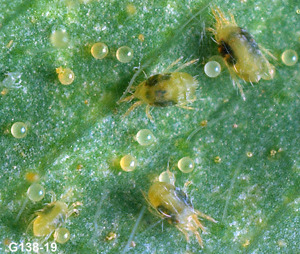
Spider mites puncture mint leaves in their attempt to extract sap and feed off from the plant.
Thus, leaving puncture wounds that end as tiny brown spots on the leaves. When the puncture wounds overtake the whole leaf, it will be hard for mint to process photosynthesis and begin to wilt and die.
Since mint leaves are edible, you may want to use an organic approach to controlling these pests.
You can wipe the leaves with rubbing alcohol and let them sit for a few hours, then rinse them off with water.
2. Aphids
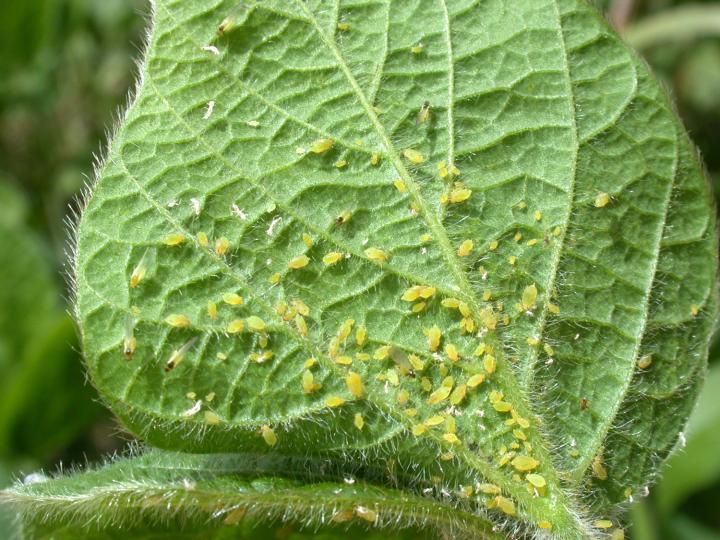
Though the scent of mint drives some species of aphids away, there are species of aphids that can also feed on mint itself. They pierce the leaves to suck out honeydew and are often found on the underside of mint leaves.
When the leaf is overtaken by too many aphids, the leaves will start to curl up, turn brown, and die.
Use a homemade dish soap solution to get rid of the aphids and their eggs.
Mix one teaspoon of oil, 3 to 4 drops of dish soap solution, and 1 quart of water. Then, use a clean cloth and wipe the mint leaves. Continue applying the solution until there are no longer signs of aphids on the leaves.
3. Four-lined Plant Bugs
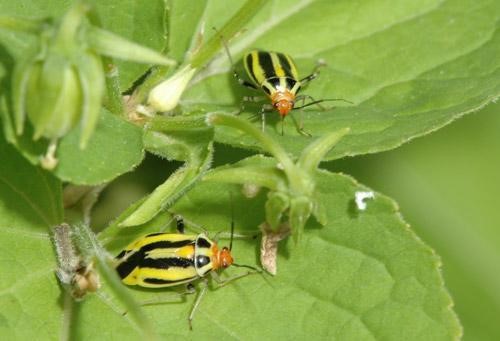
One of the common pests in mints is the four-lined plant bugs. They are oval-shaped insects that have yellow or green stripes on their backs.
They mostly attack the underside of mint leaves and leave puncture wounds that cause brown spots on the leaves.
Like aphids, you can control them using a dish soap solution or use insecticidal soap for the nymphs.
They don’t pose a threat to plants and mostly affect their appearance. However, the damage may affect the original taste and flavor of edible herbs like mint.
#4 Salts in The Soil
Mint is not a fan of salts. If the tips of the mint leaves turn brown and crispy, there might be too many accumulated salts in the soil.
Check the soil for white crystals and try to dissolve them by pouring distilled water on the soil.
The salts accumulate from the fertilizers that you use. You can leach the salts in the soil every month, so they don’t accumulate to the point that it affects your mint plants.
#5 Over-fertilization
Another possible cause of too much soluble salt in the soil is overfertilization, especially in potted mints. The excessive fertilizer in the soil limits the ability of the roots to absorb water.
Thus, leading to dehydration that results in:
- Yellow and wilted lower leaves.
- Brown leaf tips and margins.
- Brown or black roots.
- Defoliation.
- Stunted growth.
To avoid too much salt in the soils, you must use 10% liquid fertilizer other than slow-release fertilizers so that the excess fertilizer residue will leach out from the pot.
If you suspect that your mint is overfertilized, leach the salt by following the steps below:
- Pour plenty of tap water into the soil and let it drip off at the bottom of the pot. Six inches of water can reduce salts in half.
- Repeat the same step 2 to 3 hours or the next day after the first leaching.
- Let the soil rest for 2 to 3 weeks to recuperate from the leaching process.
For larger containers like raised beds, it’s best to re-pot the plants and scrape off excess salts in the container.
#6 Root Overgrowth
Mint is known for being invasive and aggressive in spreading its roots throughout the soil where it is planted. It is also the reason why mint is best grown in containers.
However, since roots of mint are contained in one location, it has a higher chance of choking itself due to root overgrowth.
Excessive roots constrict the nutrient, water, and oxygen absorption of the plant that causes deficiencies.
When a plant is in survival mode, it will start to show signs like stunted growth and brown leaves. It also becomes susceptible to plant diseases and pest infestations.
When mint is bushy and showing no issues, that’s the time that it starts to be tricky. Check the roots below and check if new roots are growing over the root ball.
If you see new growths, it’s best to split them apart from the main plant and plant them on another pot.
By transferring new growths in new pots, you’re not only preventing mint from choking itself but also propagating new mint plants.
Some gardeners even give away some of their mints due to the generous growth of this herb.
#7 Sunburns
Mints love the sun but not the scorching afternoon heat. Excessive heat can cause sunburns on the leaves, leaving brown and wilted spots.
In severe cases, the roots can dry out too that can stress the plant due to drought.
It’s best to place mint in an area where it can get morning sunlight and partial shade in the afternoon.
The good thing is mint thrives both in shade and under the sun. It’s not sensitive like other plants where shade is not an option.
If the weather is too hot and the soil gets drier than moist, adjust your watering routine and make it more frequently than usual.
Taking Care of Mint
Mint is a perennial plant which means it grows back every growing season. Due to its unique flavor and taste, it has become one of the staple herbs in the kitchen. It is entirely easy to grow and propagate.
It is not as sensitive as other plants and generously grows new roots from time to time.
Here are some of the things that you should care about growing healthy mint:
Soil Requirements
Mint loves moist and well-drained soil. Since it’s best grown in a container, you can use a potting mix made of peat moss and other organic materials to promote good drainage.
It is also beneficial to add compost to the soil since it is a good source of nitrogen and also aids in good water drainage.
Placing mulch on top of the soil can also help keep the mint leaves clean. It also helps to insulate the soil and keep it moist. Mulch also aids in preventing spores from the soil to get to the lower leaves.
Water Requirements
Mint needs an inch or two of water every week. However, you should adjust your watering routine during hot seasons to prevent drought stress in mints.
Keep it mulched to insulate the moisture in the soil and maintain a warm temperature at night.
Pest and Disease Prevention
The common pests in mints are peach aphids, spider mites, thrips, and cutworms. They can puncture the outer layer of leaves and leave yellow and brown spots on the top and underside of the leaves.
To prevent these pests from damaging your plants, here are some tips:
- Reserve insecticides for severe infestations and use organic ones like neem oil to treat mild infestations.
- If the insects are only found on two to three leaves, pick those infected leaves to control their population,
- Keep mint away from onions, garlic, or cereals since they are magnets of thrips.
- If the mind has already established strong stems, you can spray off the insects from the leaves along with their eggs. However, if mint is still developing sturdy stems, you can opt to wipe them with insecticidal soap or any homemade insecticide.
Mint can also be infected with fungal diseases. The most common ones include mint rust, blight, leaf spot, and powdery mildew.
The key to preventing plant diseases in mint is to keep it healthy and free from stress due to nutrient deficiency and drought.
Here are other tips:
- Thin out or prune mint leaves regularly to provide better air circulation. Harvesting leaves from time to time also encourages foliage and new growth.
- Water mint at the base of the plant and avoid foliar watering to prevent the spores from spreading.
- In case, your plant gets infected, remove the infected parts and apply fungicide like neem oil as soon as you can.
- Make it a habit to clean and sanitize your gardening tools in every use to avoid transferring diseases from one plant to another.
Final Thoughts
The location of the brown gives away the cause of brown spots in your mints. Brown inner mint leaves indicate overwatering or poor water drainage.
Brown spots and tips on leaves can indicate pest infestation and fungal disease. It may also be due to external factors like extreme heat and salt accumulation.
We hope that this post has been informative and answered your questions about mint leaves turning brown.
Please don’t forget to share this with your friends and let us know in the comments how you were able to save your mints.
